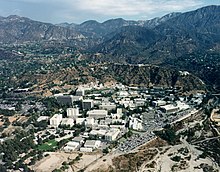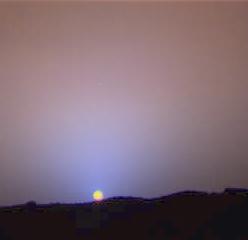
The Jet Propulsion Laboratory (JPL) is a federally funded research and development center and NASA field center in the city of Pasadena in California, United States.

The Voyager program is an ongoing American scientific program that employs two robotic Interstellar probes, Voyager 1 and Voyager 2. They were launched in 1977 to take advantage of a favorable alignment of Jupiter and Saturn, to fly near them while collecting data for transmission back to Earth. After launch the decision was taken to additionally send Voyager 2 near Uranus and Neptune to collect data for transmission back to Earth.

An aerobot is an aerial robot, usually used in the context of an unmanned space probe or unmanned aerial vehicle.

The Goddard Space Flight Center (GSFC) is a major NASA space research laboratory located approximately 6.5 miles (10.5 km) northeast of Washington, D.C. in Greenbelt, Maryland, United States. Established on May 1, 1959 as NASA's first space flight center, GSFC employs approximately 10,000 civil servants and contractors. It is one of ten major NASA field centers, named in recognition of American rocket propulsion pioneer Robert H. Goddard. GSFC is partially within the former Goddard census-designated place; it has a Greenbelt mailing address.
New Millennium Program (NMP) was a NASA project with focus on engineering validation of new technologies for space applications. Funding for the program was eliminated from the FY2009 budget by the 110th United States Congress, effectively leading to its cancellation.
Wesley T. Huntress, Jr. is an American space scientist. An astrochemist and space scientist, Huntress worked for about twenty years at NASA's Jet Propulsion Laboratory. During the 1980s he was also a video game designer, producing games for Apple computers. In 1988 Huntress moved to NASA headquarters, where he would serve in several positions, including Director of NASA's Solar System Exploration Division and Associate Administrator for Space Science.

Charles Elachi is a Lebanese-American professor (emeritus) of electrical engineering and planetary science at the California Institute of Technology (Caltech). From 2001 to 2016 he was director of the Jet Propulsion Laboratory and vice president of Caltech.

Claudia Joan Alexander was a Canadian-born American research scientist specializing in geophysics and planetary science. She worked for the United States Geological Survey and NASA's Jet Propulsion Laboratory. She was the last project manager of NASA's Galileo mission to Jupiter and until the time of her death had served as project manager and scientist of NASA's role in the European-led Rosetta mission to study Comet Churyumov–Gerasimenko.
The Planetary Data System (PDS) is a distributed data system that NASA uses to archive data collected by Solar System missions.

A space probe, or simply probe, is a robotic spacecraft that doesn't orbit the Earth, but instead explores farther into outer space. A space probe may approach the Moon; travel through interplanetary space; flyby, orbit, or land or fly on other planetary bodies; or enter interstellar space.

The Near-Earth Object Surveillance Mission (NEOSM), formerly called Near-Earth Object Camera (NEOCam) is a planned space-based infrared telescope designed to survey the Solar System for potentially hazardous asteroids.

The Asteroid Redirect Mission (ARM), also known as the Asteroid Retrieval and Utilization (ARU) mission and the Asteroid Initiative, was a space mission proposed by NASA in 2013. The Asteroid Retrieval Robotic Mission (ARRM) spacecraft would rendezvous with a large near-Earth asteroid and use robotic arms with anchoring grippers to retrieve a 4-meter boulder from the asteroid.
Bonnie J. Buratti is an American planetary scientist in the Division of Earth and Space Sciences at the Jet Propulsion Laboratory in Pasadena, California, where she leads the Comets, Asteroids, and Satellites Group. Her research involves the composition and physical properties of planetary surfaces, and volatile transport in the outer solar system.

The Near-Earth Asteroid Scout is a planned mission by NASA to develop a controllable low-cost CubeSat solar sail spacecraft capable of encountering near-Earth asteroids (NEA). The NEA Scout will be one of 13 CubeSats to be carried with the Artemis 1 mission into a heliocentric orbit in cis-lunar space on the maiden flight of the Space Launch System (SLS) planned to launch in 2021. The most likely target for the mission is 1991 VG, but this may change based on launch date or other factors. After deployment in cislunar space, NEA Scout will perform a series of lunar flybys to achieve optimum departure trajectory before beginning its two-year-long cruise.

Amanda R. Hendrix, Ph.D. is an American planetary scientist known for her pioneering studies of solar system bodies at ultraviolet wavelengths. She is a senior scientist at the Planetary Science Institute. Her research interests include moon and asteroid surface composition, space weathering effects and radiation products. She is a co-investigator on the Cassini UVIS instrument, was a co-investigator on the Galileo UVS instrument, is a Participating Scientist on the Lunar Reconnaissance Orbiter LAMP instrument and is a Principal Investigator on Hubble Space Telescope observing programs. As of 2019, she is also the co-lead of the NASA Roadmaps to Oceans World Group.

David A. Spencer is the Mars Sample Return Campaign Mission Manager at the Jet Propulsion Laboratory. As an aerospace engineer, Spencer designs and operates planetary spacecraft.

Farah Alibay is a Canadian systems engineer at the NASA Jet Propulsion Laboratory (JPL) who has worked on the InSight, Mars Cube One, and Mars 2020 missions.

David Y. Oh is an American spacecraft systems engineer and expert in electric propulsion. Oh currently works at the Jet Propulsion Laboratory (JPL) as the NASA Psyche mission Project Systems Engineering Manager. Prior to his role on Psyche, he was the cross-cutting phase lead and lead flight director for the NASA Mars Science Laboratory mission and was recognized in popular media for living on Mars time with his family during the month following the landing of the Curiosity rover.


















